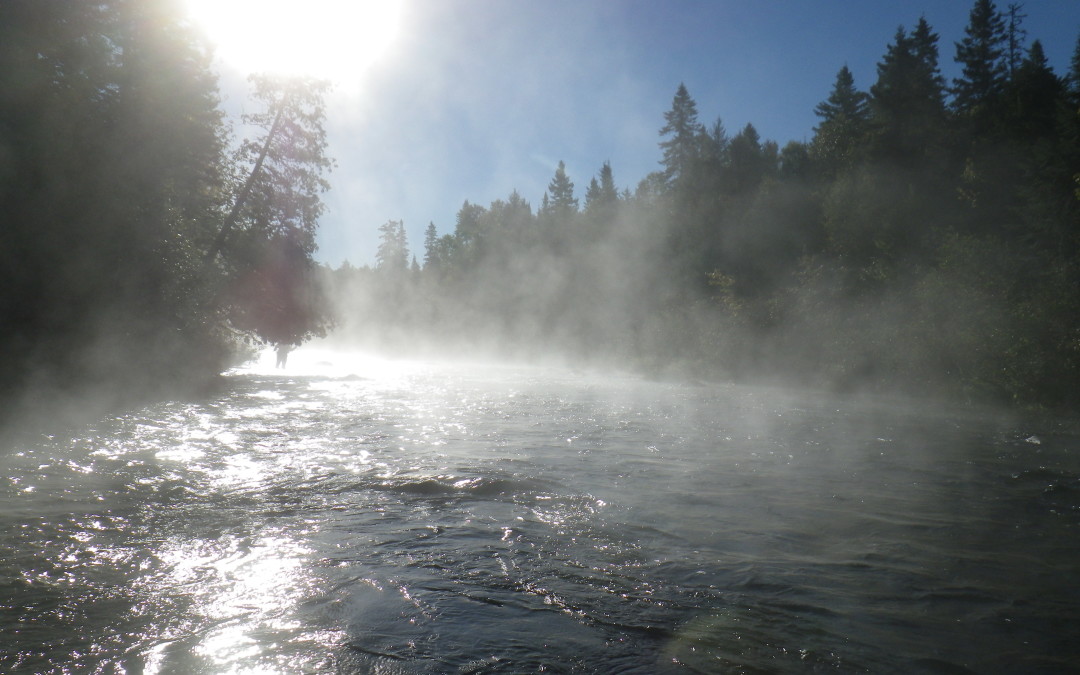This past September has been a very difficult month with warmer than normal temperatures and warm water. The lack of water in many of the rivers have kept the spawning salmon from entering the rivers to start their spawning runs. The flows on the Roach River were not increased to stimulate the spawning runs until the 9th of September and the fishing in the early part of the month was tough. The rule of thumb for this river is that the flows will be increased on the Tuesday after Labor Day. There needs to be enough water in 1st Roach Pond to sustain these flows for the duration of September and October. Data from previous studies using weirs (a device used to trap fish in the water) set-up on the lower section of this river have shown that when the water warms too much the salmon and trout retreat back to Moosehead to wait for colder water. Even with these challenges the most difficult part of this month was a personal loss that no one can prepare for. My mother passed away unexpectedly on the 18th. I was very close to my mother and am still trying to come to terms with this loss. She was my biggest supporter throughout my life and was very proud when I became a guide and started up a guide service. Even if I hadn’t seen her for a while she would always ask if I had been fishing and encouraged me to get out on the water. Initially after this loss I could not fathom the idea of going to the Roach River or even leave the house. Everyone in my family that I talked to said that I should go as that was what Mom would want me to do. I needed time to think, heal and remember all of the good things about my mother.
With the decision to get back on the water I decided to stay close to home and fish the Crooked River. It was great to be on the water again and it was also nice to have Jeff fishing with me for an extended time. It was later in the month of September and the salmon should have been up past Scribner’s Mills where the spawning beds are located. We started in that section and Jeff hooked into some very nice native brook trout, with the biggest one over 13″. This river has been managed for all wild trout and salmon and any stocking efforts have been discontinued many years ago to maintain this native quality. Every year there are much bigger trout caught along this stretch indicating that the population is strong and healthy. We picked up a few more nice trout on the way down river until we got to a pool that traditionally holds a lot of salmon. There was another angler in this pool, but as with other good natured anglers we struck up a conversation regarding the fishing. When anglers talk and have good ethics and respect the resource then everyone wins. Do not crowd other anglers when you first get to the pool, but rather wait to see where they are going and most will acknowledge you. At this point you can ask if you could work up or down from their position. This has worked for me time and time again, with the rare exception, and is a good rule to live by. All I want to know is that other anglers understand that no one owns the water, we just need to know how to work with others.
With this new acquaintance our conversation quickly turned to the multitude of salmon in the pool. The water was low and clear and the sun was bright, not the best conditions for salmon fishing as they become much more skittish with any shadows or movement from around the pool. However, I wanted to see and stood on a rock in the pool where I had a great vantage point. The key here is to have a good pair of polarized sunglasses and a hat with a bill over your eyes. I cup my hands on either side of my hat brim to further block any glare from the sun off the water. Then I let my eyes acclimate to the water. Very quickly I began to see the salmon in the pool. There were some very nice sized male salmon sparing in the pool and chasing the female salmon off of their resting spots. One might ask how can you tell the difference between the males and females without catching them. In this river it is based on size. The females are much smaller, with a smaller head, while the males are considerably larger and many start to develop a kype jaw. A kype develops in male salmon during the spawn and the lower jaw curves upward and many times distort the upper jaw. In this situation when I can see the salmon and easily cast to them I utilize the short line nymphing technique, which means no indicator, and there is minimal leader material so that you can maintain direct contact with your nymph. I also call this walking the dog as one uses the rod to slowly “walk” the nymph along the bottom. I attached a couple of split shot around eight inches above the nymph to get the fly down quickly and into the sight of the salmon in the pool. I also use a nymph that I can see easily so that I can watch its progress so that I can adjust as necessary. When I would get a good drift and the nymph would pass very closely to the nose of the salmon their reaction is very important. If the salmon moves away or has no reaction then that fly will not work. I have actually bumped the nose of a salmon with no reaction. That fly was changed immediately. When you finally find a nymph that the salmon makes a motion toward then you are in business.
I had been watching a pod of male salmon chasing each other around and finally one of the larger males moved three female salmon out of their holding area not very far from my position. With the right nymph all I had to do now was get a good drift, but that may not always be enough. After a few drifts where the salmon showed interest, but did not take, I added in a bouncing motion as it approached the salmon. I saw the salmon move his head toward the fly and take the nymph decisively. With a solid hook set it was now game on. This pool has many sunken logs where a large salmon can run and break your line. I also had four pound test on my tippet to match my size 16 Bloody Mary nymph and needed to be careful. However, I had to be decisive in how I played this fish so that I would not lose it. I kept my rod at an angle up stream to guide the salmon away from the logs and into more open water. Now I had to get into a better position and with the assistance of Jeff I took a flying leap off the rock I was standing on and almost went completely under due to my excitement. It is vitally important to fight a fish this size the right way, or any fish for that matter. I have watched how many anglers traditionally play fish and most hold their rods high in the air in a desperate attempt to gain control of the fish. The only problem with that is you are using the weakest part of the rod, the tip, to play your fish. The more efficient and effective method is to hold the rod to the side at a low angle and you will immediately feel more control over the fish and all of the weight is transferred to the butt of the rod, which is strong and meant for this type of stress. Using this method you will keep the fight shorter and the survival rate of your fish will be increased dramatically. Do not kid yourself that the act of fly-fishing alone is better for the fish as Jeff and I have both seen many fish over played and mis-handled that surely died within a few hours after being released.
This salmon was very strong and had a few more leaps out of the water before we began thinking of bringing it to net. Keep your drag on your reel tight enough that when the salmon sees you or the net it will make a series of runs that you can handle. Another important point while trying to net a fish is to keep it in the water as bringing the fish out of the water too much increases the amount of tension on your line and you can easily break them off. After many attempts, we finally netted this beautiful fish. Immediately I reached in with my clippers and cut the line to prevent the fish from rolling and tangling itself in the line. After the fish is out of the net and being revived then you can attempt to take out your fly. Luckily for me the fly was perfectly on the side of its mouth and was easily removed. Now with a bigger fish you will need to take more time to revive them as the lactic acid needs time to dissipate. I spent at least ten minutes working the fish back and forth, while in the water, letting water rush through its gills. Another trick that I was shown as a youngster was flipping a fish upside down in the water to re-orient them. More times than not the fish shows more vigor after that. When I thought the fish had been revived enough I loosely held him in the water and it took off with a splash that sent water on my face.
Now this was the first day on the water since my mother had passed and this fish was very special to me. This was the largest salmon I had ever caught and landed and it couldn’t have come at a better time for me personally. This was a great moment as the three of us stood on the side of the river enjoying the moment. Knowing that not many of the pools in this river have names we decided to name the pool after my mother. I do not care if no one else calls this pool by the name that I gave it because it means so much to me. I will always call it “Bonnie’s Pool.”










